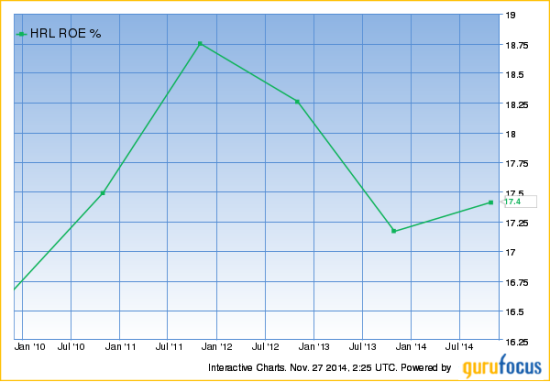Understanding ROE ROCE
Post on: 16 Март, 2015 No Comment

Understanding ROE & ROCE.
by J Victor on August 9th, 2010
RETURN ON EQUITY (ROE)
‘Equity’ means shareholders funds.
Share holder’s funds in a company includes the equity capital they invested + their share of earnings retained by the company for further expansion.
Hence, return on equity means, the return generated by using shareholder’s capital.
How does a company generate return from it’s capital? It’s by investing in assets which are capable of producing returns. So, Return on Equity (ROE) is a measure of how efficiently a company uses its assets to produce earnings. ROE is the speed at which the company might grow without sorting to additional fund raising.
The formula for computing return on equity is:
- Earnings / shareholders equity
Instead of taking the ROE figure of just one year and forming an opinion on that basis, it’s better to study the financial history of the company and find the average ROE of 5 or more years. This would give you a reasonable assurance about the rate of return that the company is capable of generating.
An average ROE of 15% -20% is the preferred range for a company that’s growing at a steady pace.
THREE COMPONENTS OF ROE
The ROE is not a simple equation as you saw above. Let’s try to split and expand the equation and try to find what boosts the ROE of a company and why. Let’s check the expanded formula.
- ROE= (Earnings / Sales) x (Sales / Assets) x (Assets / Shareholder’s equity)
If you notice the equation carefully, you’ll take note that ‘sales’ and ‘assets’ are both the numerator and denominator and hence they get nullified. When we break the equation in this manner, the three components of ROE is revealed. They are;
- Earnings or profits
- Assets
- Leverage
Earnings or profits:
Profits, in simple terms, are the money left after all the expenses is met. So the first part of the equation – (earnings / sales) shows the profit margin that’s generated by the company from its sales. A low profit margin can mean many things including:
- Inefficient pricing policy
- Inefficient cost control ( hence a drop in profits)
- Unprofitable product ( hence it eats into the profits generated by other products of the company)
- Cut throat competition ( hence, the company is forced to sell at a low margin)
A high profit margin, on the other hand, may mean that the company is enjoying a monopoly in its field. It also indicates that the company has a product or product range that has some brand image and quality and hence it’s possible for them to sell their products at a higher margin. Such companies are also capable of eliminating competition from new entrants by lowering the prices temporarily or by enhancing the quality of the product without enhancing the price.
Assets:
The second part of the equation is sales / assets. So that measures the sales generated from per rupee of assets invested by the company. It’s also called asset turnover ratio.
The asset turnover ratio of a company throws light into an important aspect. How much assets does the company need to generate the required volume of sales? If the company is capable of generating sales by investing heavily in assets, it could mean that the company is capital intensive in nature. The capital intensive nature of the company affects the ROE of the company negatively.
Leverage or debt:
The last part of the equation is assets / shareholder’s equity. It is basically a measure of leverage. Leverage is nothing but the amount of debt funds used by the company to sustain business. If the ratio is less, it shows that the company has resorted more to debt funds. If the ratio is 1 it shows that the company has built all the revenue producing assets from shareholders funds.
if a company raises funds through to do business through borrowing rather than issuing stock it will reduce its shareholders equity. A lower equity means that you’re dividing earnings by a smaller number, so the ROE is artificially higher.
So, higher the debt, higher the ROE.
So, earnings, assets turnover and debt are the three factors that boost the ROE of a company. Hence,
- ROE = Net margin x asset turnover x financial leverage.
In general, It’s important to screen companies for a higher earnings, higher assets turnover and a lower debt.
RETURN ON CAPITAL EMPLOYED (ROCE)
ROCE is different from ROE we discussed above. ROCE is the ability of the company to earn return from ‘all the capital’ it employs. The term ‘All the capital’ means that it includes debt funds like loans and preference capital as well.
The equation for computing ROCE is:
- Return (before interest and Tax) / capital employed.
Debt funds are included in the denominator; logically the numerator should be the earnings before deducting the interest paid on debts.
For a company to remain in business over the long term, it’s important to generate an ROCE which is higher than its ‘cost of capital’. ‘Cost of capital’ is nothing but the compensation that the company should pay to each category capital contributors. That is, for using debt it has to pay interest, for preferred capital it has to pay a fixed return and for ordinary equity holders it has to pay what the equity holders expect – something above the risk free return rate and average return they expect from any other stock investment.
Since the proportion of equity, preferred capital and loan funds would be different, the weighted average of all is taken as the cost of capital of a company.
The higher the ROCE, the better it is.
So that’s about ROE and ROCE.
Bye for now….
……have a nice day.
You may like these posts:














